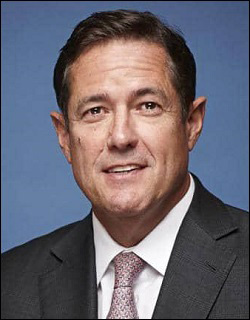By Pam Martens and Russ Martens: August 12, 2019 ~

Jes Staley, Former JPMorgan Chase Executive, Visited Epstein While He Was Serving Time in Florida as a Sex Offender
Jeffrey Epstein, the accused pedophile and sex trafficker of underage women to powerful men around the world according to allegations in court documents, was found dead in his jail cell at the Metropolitan Correctional Center in Manhattan on Saturday morning. The Justice Department is reporting the death as a suicide, despite the fact that Epstein should have been monitored by police around the clock because of an earlier attack or attempted suicide just weeks before in his jail cell.
Epstein had close ties to JPMorgan Chase. He now joins a dizzying roster of suspicious deaths connected to JPMorgan Chase – particularly among its technology executives, who allegedly jumped to their death from JPMorgan buildings; died in two separate cases of murder-suicides in seven months; died of alcohol poisoning or, in the most recent case of Doug Carucci in March of this year, simply died “tragically” and “suddenly” with all efforts to obtain the tiniest shred of information about what happened hitting a brick wall.
In the case of Carucci, who lived in Manhattan, even the New York City Medical Examiner’s Office stated that it had no information at all on any such individual, despite the requirement in New York City that any sudden or accidental death must be examined by that office. Raising more suspicions, mainstream media would not touch the story of Carucci’s death despite the fact that he was a high-ranking employee of JPMorgan Chase as Global Head of Currencies, Emerging Markets, and Commodities Technology and Global Head of FICC Electronic Trading Technology.
Suspicions surrounding Epstein’s death have come from members of Congress and former high-ranking law enforcement officials. The U.S. Attorney General, William Barr, has asked the Justice Department’s Inspector General to open an investigation into Epstein’s death. The FBI is also investigating.
Epstein’s ties to JPMorgan Chase date back to at least 2001 when Epstein presided as Chairman over an offshore company incorporated in Bermuda, Liquid Funding Ltd. As Wall Street On Parade previously reported, the company grew to at least $6.7 billion in outstanding liabilities. The company appeared to be propping up dodgy subprime mortgage dealers by giving them loans. Bear Stearns, where Epstein had worked from 1976 to 1981, owned 40 percent of the equity in the company. JPMorgan Chase was one of three banks providing a $250 million liquidity facility to Liquid Funding Ltd. JPMorgan Chase was also listed as its “Security Trustee.”
JPMorgan Chase is the largest bank in the U.S. and is itself a three-count felon. The bank has been compared to the Gambino crime family in a deeply researched book by two trial lawyers, Helen Davis Chaitman and Lance Gotthoffer. The lawyers write that “…like the Gambino crime family, JPMC recognizes that getting caught is just the cost of doing business illegally.” The lawyers then proceed to list a jaw-dropping chronology of illegal acts by the bank.
The Chairman and CEO of JPMorgan Chase is Jamie Dimon, who has remained at the helm of the bank despite those three felony counts that happened on his watch. Two felony counts came in 2014 as a result of JPMorgan Chase’s handling of the business bank account of Ponzi master Bernie Madoff where it ignored flagrant signs of money laundering while proceeding to tell U.K. regulators (but not U.S. regulators) that Madoff might be running a Ponzi scheme. In 2015 the bank was hit with another felony count along with other banks for rigging foreign exchange trading. The bank admitted to all three felony counts.
In 2013 the U.S. Senate’s Permanent Subcommittee on Investigations released a 300-page report on JPMorgan Chase’s high-risk derivatives trades in London that cost its depositors at least $6.2 billion in losses (London Whales trades). Since the financial crisis, the bank has paid out more than $36 billion to settle a myriad of fraud charges against the investing public and innocent consumers. The bank is currently under yet another criminal probe for potentially illegal manipulation of gold and silver markets.
Wall Street’s self regulator, FINRA, has decided to put up a personal page for Dimon at its BrokerCheck website, where investors go to check on misdeeds by a potential broker they are considering for investment advice. Dimon’s career history had been missing from BrokerCheck for many years – and we can assure you that Dimon has been named in far more legal actions than FINRA lists on its site. But the three most recent disclosures that FINRA does list for Dimon, for 2014, 2015 and 2016, all say “Criminal.” That’s not really the profile one wants to see for the top executive of the largest bank in the U.S. – and yet his richly compensated Board of Directors doesn’t sack him.
Dimon has requested to add this comment on his FINRA page after each of the criminal disclosures: “Mr. Dimon is disclosing this matter because, in certain respects unrelated to the underlying conduct, he may be deemed to have exercised control over JPMCB. There are no allegations or facts set forth in the information that refer to Mr. Dimon personally.” In the U.S. Senate’s investigation of JPMorgan’s London Whale trades, Dimon’s name is mentioned 298 times, and not in a good way.
If you are a heavily regulated bank in the midst of receiving large amounts of taxpayer support in the midst of the greatest financial crisis since the Great Depression, one would think you would have the good sense not to be chumming around with felons – particularly those sexually assaulting under-age girls. But this is what the New York Times reported on July 22 of this year:
“When Jeffrey Epstein was serving time in Florida for soliciting prostitution from a minor, he got a surprising visitor: James E. Staley, a top JPMorgan Chase executive and one of the highest-ranking figures on Wall Street.
“Mr. Staley had good reason to maintain his relationship with Mr. Epstein, who received him at his Palm Beach office, where he had been permitted to serve some of his 13-month sentence in 2008 and 2009. Over the years, Mr. Epstein had funneled dozens of wealthy clients to Mr. Staley and his bank.”
Staley is now the Chief Executive of the British bank, Barclays, another of the banks charged in 2015 for rigging foreign exchange trading along with JPMorgan Chase.
It should be noted that Epstein wasn’t simply serving time for soliciting sex from a minor. At the time, the Justice Department had prepared a 53-page indictment against him with evidence that he had sexually assaulted dozens of underage school girls. Why Epstein got off so easy is now also under investigation.
Bloomberg News reported just five days before Epstein’s death that Staley and his wife had also visited Epstein on his private Caribbean island, Little St. James, in April 2015. Staley was no longer employed at JPMorgan Chase at that time.
The Times article also reveals that Epstein was involved with Staley in brokering a deal where JPMorgan purchased a majority stake in the hedge fund, Highbridge Capital Management, which was co-founded by Glenn Dubin and Henry Swieca. The Wall Street Journal reported that Epstein was paid $15 million for brokering the deal.
FINRA data shows that Highbridge Capital had affiliates in secrecy jurisdictions like the Cayman Islands, Luxembourg and Jersey.
Even after Epstein served his jail term as a sex offender, Glenn Dubin remained friendly with him. Documents in a defamation lawsuit against Ghislane Maxwell, Epstein’s longtime girlfriend whom multiple young women have accused of joining Epstein in their sexual abuse, were unsealed on Friday. In those 2,000 documents, Virginia Giuffre charges that Maxwell directed her to have sex with Dubin, among numerous other powerful men. Giuffre also told the Miami Herald in a 2017 interview that Epstein asked her to sexually please numerous powerful men so that he could use the information as leverage if needed.
Just two days before Epstein’s untimely death, taking many of the secrets of his relationship with JPMorgan to the grave with him, New York Times’ reporters Emily Flitter and Jessica Silver-Greenberg wrote that compliance officers at JPMorgan Chase had recommended a decade ago the closing of Epstein’s account at the bank because of legal and reputational risks. The recommendations came after his guilty plea in 2008 to sex crimes. According to the report, which a spokesperson for JPMorgan denies, Mary Erdoes, one of the bank’s top executives, intervened to stop the account purge. The reporters add this:
“The episode is another example of how powerful institutions and individuals, eager to profit from Mr. Epstein and his network of wealthy acquaintances, looked past his criminal history and sex offender status. As a result, he managed to retain crucial business connections even as, prosecutors said in a federal indictment last month, he engaged in the sexual trafficking of girls as young as 14.”
JPMorgan Chase has had an uncomfortably cozy relationship with law enforcement through the years. As we reported in 2012, an employee of JPMorgan Chase (along with several other Wall Street bank employees) was allowed to sit elbow to elbow with New York City Police officers in a high-tech surveillance center dubbed the Lower Manhattan Security Coordination Center watching thousands of street-level surveillance cameras as they spied on the comings and goings of pedestrians. As we wrote at the time, “Not only is it unprecedented for corporations under serial and ongoing corruption probes to be allowed to spy on law abiding citizens under the imprimatur of the largest police force in the country, but the legality of the operation by the NYPD itself is highly questionable.” (See 60 Minutes Takes a Pass on Wall Street’s Secret Spy Center.)
JPMorgan Chase has also through the years maintained a steady roster of former CIA and Secret Service officials. Thomas Higgins, the former Senior Officer and Station Chief in the CIA’s National Clandestine Service, was previously the Global Head of Operational Control for the bank. Bud Cato, a Regional Security Manager for JPMorgan Chase from 2011 to 2014, had worked for the CIA in foreign clandestine operations from 1982 to 1995 and in Middle East operations from 2001 to 2011.
After the Justice Department released the charges against JPMorgan Chase in connection with the Bernie Madoff Ponzi scheme, the Los Angeles Times asked in a photo caption of a smirking Madoff outside of Federal Court: “Bernie Madoff: Was he part of the JPMorgan ring, or was JPMorgan part of his ring?”
Throughout his serious brushes with law enforcement, Epstein also wore a perpetual smirk in photos, as if he knew his powerful connections would protect him. It’s now time to ask the question, “Was Jeffrey Epstein part of the JPMorgan ring, or was JPMorgan part of his ring?”


